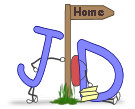
|
<<Back |
Geneva, Switzerland
January 7,
2006 |
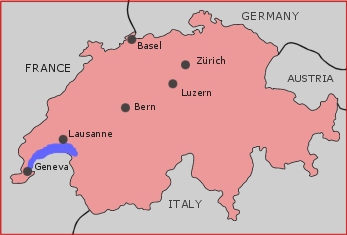
|
|
|
|
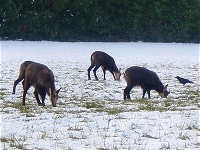
Grazing chamoix.
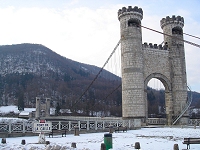
Pont de Caille spans the Usses
gorge.
|
After her holiday visit with
D, who was still working in the French Alps, J had just
enough time for a day trip prior to her return home.
After weighing the options, we decided to make a run
for Geneva to spend D's leftover Swiss francs.
The Swiss have a long-standing
relationship with money. If it's not evident from
their reputation for banking, it most certainly is
with regard to the toll that they demand to enter
their country. While the French are content with charging
$10 here and $5 there, the Swiss charge $30 to pass
into Geneva. Although it's a one-time charge, they
don't prorate it. So whether you buy the toll vignette
on January 1 or on December 30, it's going to run
you $30 and it's going to expire on December 31. A
brilliant scheme aimed at gouging the tourist. The
French living near Geneva have even developed a black
market for used vignettes.
We aimed to avoid making the
investment, not for financial reasons but on principal,
and therefore decided to go cross-country and take
the back roads into town. It gave us a chance to see
a little of the Haute Savoie that we would otherwise
have missed.
|
|
|
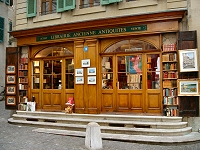
A wooden façade in the
vieille ville.
|
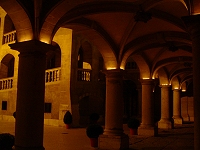
The courtyard of the Hôtel de
Ville .
|
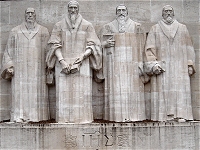
The Wall of the Reformation.
|
|
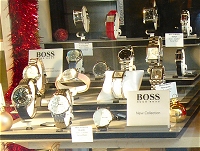
Swiss timing.
|
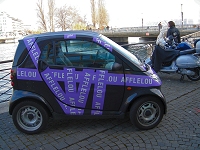
The Swiss-made Smart Car looks
like an oversized roller skate but gets 60 mpg.
|
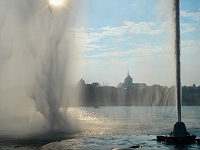
At the Jet d'Eau.
|
|
|
There is nothing ordinary about
Geneva. Located on the western-most extremity of Switzerland
and the western-most point of what the locals call
Lac Léman, it shares 95% of its border with
France, leaving only a narrow strip of land to connect
it to greater Switzerland. The layout of the city
is segmented by the Rhône as it makes its way
from Lake Geneva to the Mediterranean, the Rive
Gauche containing the former walled origins of
the town and the Rive Droite accommodating
the more modern Geneva. Historically, it has always
been a major player having been a major outpost for
the Romans before passing to the Burgundians and eventually
Charlemagne. The Dukes of Savoie repeatedly attempted
to control Geneva in order to consolidate their Alpine
territories. One such incursion in December 1602 resulted
in the Savioe army attempting to scale the city walls.
The citizens of Geneva fought them off with anything
they could lay their hands on including frying pans
and kettles of hot soup, eventually routing the invaders
while losing less than twenty of their own. The event
is celebrated annually as l’Escalade (the scaling)
with a city-wide festival involving the smashing of
chocolate cauldrons filled with marzipan vegetables.
The departure of the Savoyards was followed by a brief
French occupation until Geneva was finally admitted
to the Swiss confederation in 1815.
Geneva’s shoreline and scenic
views of the Alps made it a major stopover on the
famed Grand Tour of Europe in the late 19th century.
Voltaire and Rousseau called the city their home,
and it was also the setting for much of Mary Shelley’s
Frankenstein. However, it was the arrival of
the exiled preacher Jean Calvin during the Reformation
that elevated Geneva to a center of Protestantism
and earned it the nickname of the “Protestant Rome”.
Having avoided the destruction that so many other
war-ravaged European cities, the 16th century vieille
ville (old city) of Geneva is a well-preserved,
albeit small, nest of winding cobblestone streets
lined by the unique wooden façades of shops
and restaurants. The St. Pierre cathedral dominates
the hill on which the old town was built and contains
the chair from which Calvin preached his doctrine
of reform for thirty years. Outside the remaining
ramparts in the Parc des Bastions is the Wall of the
Reformation which is dedicated to influential Protestant
figures such as Martin Luther, Oliver Cromwell, and
Roger Williams, founder of Rhode Island, but it is
dominated by the four statues of Guillaume Farel,
Théodore de Bèze, John Knox, and Calvin
himself.
As one wanders down to the
bridges that span the river to the Rive Droite,
it is impossible not to notice Geneva’s aquatic symbol
- the Jet d’Eau (water jet). Originally, a
pressure release system for a reservoir project, Europe’s
tallest fountain now has a dedicated pumping system
the shoots a plume to a height of 450 ft and at a
rate of over 100 gal per second. The walk out along
the narrow pier leading to the nozzle can be a harrowing
experience on a windy day – especially in January.
|
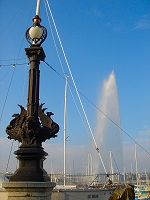
Along the quai on Lake Geneva.
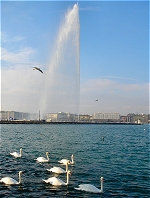
Seven swans a'swimming.
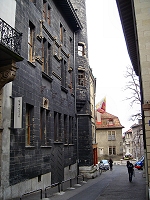
The 14th century Maison Tavel
with its carved human heads.
|
|
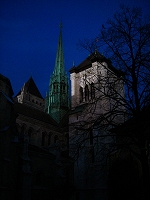
St. Pierre cathedral.
|
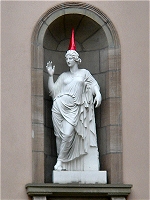
Traces of the recent Escalade
celebrations.
|
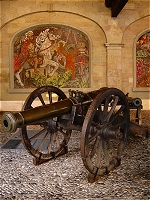
Cannons once protecting the
city at the Armory.
|
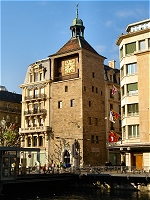
The Tour d'Île on an island
in the Rhône.
|
|
|
|
If you stroll through the streets
of the Rhône’s more modern northern bank, you
are constantly reminded of the wonderful things that
make Switzerland famous - chocolate, cheese, watches,
pocketknives, and banks. Venture out far enough, and
you will note another – neutrality. To the north of
the city center is the Parc des Nations, a large park
around which are located a number of international
organizations such as the World Intellectual Property
Organization, World Health Organization, World Trade
Organization, International Organization for Standardization,
Amnesty International, UNICEF and close to 250 other
international organizations. The park itself constitutes
the grounds of the Palais des Nations which was built
to host Woodrow Wilson’s ill-fated League of Nations.
It is now home to nearly 3,000 diplomats as the European
headquarters of the United Nations.
Across from the Palais des
Nations is the headquarters of the International Red
Cross. After visiting the site of a particularly heinous
battle between the Austrians and French armies in
1859, the Geneva-born banker and philanthropist Henri
Dunant was so appalled at the loss of human life and
the suffering of the wounded that he proposed an international
agreement on the treatment of soldiers. Dunant’s suggestion
led to the ratification of the Geneva Convention in
1864 and the eventual birth of the Red Cross as a
humanitarian organization. While the inverted Swiss
flag was used as its emblem, the Red Cross later adopted
the Red Crescent and just recently the Red Crystal
as supplementary symbols. For his efforts, Durant
was awarded the very first Nobel Peace Prize in 1901.
In fact, residents of Geneva have won 44 Nobel Prizes
over the years.
The Red Cross complex also
contains a museum dedicated to worldwide human suffering.
Not being big fans of museums anyway, this looked
like another one we should pass on. Instead, we headed
back into the old town for a quick twilight tour before
settling in to a warm dinner of pasta topped with
a mascarpone and sherry sauce and a nice bottle of
Swiss white wine.
|
|
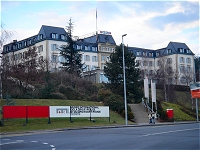
Headquarters of the Red Cross/Red
Crescent/Red Crystal.
|
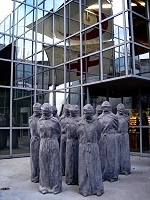
Memorial to refugees everywhere
at the International Red Cross museum.
|
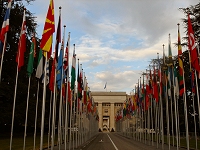
Palais des Nations.
|
|
Copyright © 2005 JnDsTravelog.com. All rights reserved. |
| |